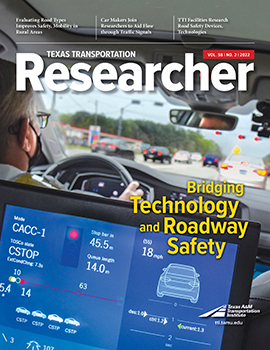The Texas A&M Transportation Institute’s (TTI’s) Visibility Research Laboratory and smart intersection explore how improvements in road markings, signals and equipment can keep road users safe.
Through the Eyes of the Visibility Research Laboratory
Researchers in TTI’s Visibility Research Laboratory evaluate retroreflective materials, lights, coatings and other technologies designed to provide nighttime visibility. The lab is a 140-foot-long by 15-foot-wide corridor in TTI’s headquarters building on the Texas A&M-RELLIS campus. Ventilation systems allow full-size vehicles to operate in the lab during human factors testing and headlamp studies. To simulate a dark environment, lighting controls can turn off all lighting, and the walls, floor and ceiling are all black.
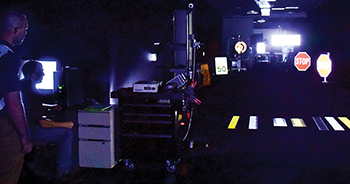
The lab leverages advanced technologies such as retroreflectometers, high-megapixel imaging colorimeters, and light detection and ranging systems. With these tools, researchers can measure photometric characteristics (color and brightness as evaluated from a human eye) of sign sheeting, pavement markings, raised retroreflective pavement markers and other retroreflective devices to improve safety for all road users. Researchers can also test a vehicle’s lighting system and how it may impact visibility on a roadway. The Visibility Research Laboratory is home to a four-axis photogoniometer where researchers rotate various retroreflective devices to observe light intensity at specific measurement geometrics. Understanding how light interacts, especially from multiple angles, can inform specification design and potential safety improvements.
Studies conducted in the lab include:
- observing how drivers interpret various traffic control devices,
- calibrating data collection equipment for field applications, and
- conducting standardized and non-standardized evaluations of traffic control devices.
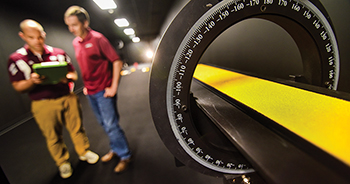
“The lab’s research often results in guidance used to support development of and modifications to existing specifications for various traffic control devices,” says Adam Pike, TTI Signs and Markings program manager and associate research engineer. “This guidance can improve the visibility, durability and safety performance of the devices.”
“We often host student groups who tour the lab to learn about the research we do,” says Pike. “We’re able to show them how traffic signs and pavement markings are used to provide a safe driving environment and how we evaluate the devices’ performance to make sure they are functioning properly.”
Conversing in Data at the Smart Intersection
TTI’s smart intersection project advances research in traffic signal control, detection technology and connected vehicle infrastructure to increase awareness and safety on roadways. Located on the RELLIS campus, the smart intersection is a fully actuated span-wire intersection with flashing yellow arrows and dedicated short-range communications (DSRC) equipment. TTI, Econolite, other vendors and the Texas Department of Transportation contributed to the intersection installation and additional research equipment.
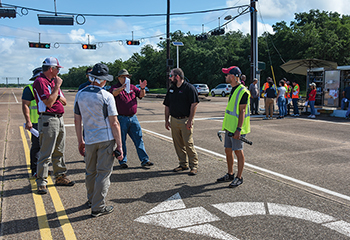
The intersection’s poles can accommodate detection and communication equipment for conducting a variety of tests. One cabinet houses a controller, and another contains additional research equipment. The intersection also includes a painted pedestrian and bicyclist crosswalk with signals at both ends. Other capabilities include:
- radar tracking for northbound and southbound approaches;
- video detection for all four approaches;
- a GRIDSMART® system for detecting pedestrians, bicyclists and vehicles at the stop bar; and
- numerous DSRC radios constituting the connected infrastructure.
The smart intersection recently supported the TOSCo project to conduct end-to-end testing of all system components before TOSCo was deployed in real traffic along FM 1960 in Houston. The TOSCo project broadcasts signal phase and timing data after fusing queue length and green window information to allow TOSCo-capable vehicles to adjust their speeds approaching signalized intersections to minimize fuel consumption and emissions.
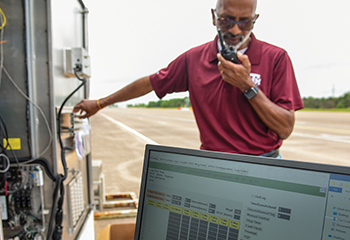
Researchers use the smart intersection to install and evaluate advanced signal control, detection, DSRC/cellular vehicle-to-everything and other connected infrastructure equipment. In light of the increasing interest in connected vehicle applications, this intersection helps research teams test the interoperability of signal control with connected infrastructure, which could inform policy making and transportation planning.
TTI Research Engineer Srinivasa Sunkari says, “The smart intersection is undergoing a significant improvement in conjunction with the runway renovations at the RELLIS campus. The smart intersection will have a mast-arm configuration, with radar and video sensors installed on mast arms to significantly improve detection capabilities and hence support a more robust testing environment.”
